Storyboarder - Job description
Missions, activities, skills, training
Storyboarder - Job description
What is a Storyboarder?
At the pre-production stage, the Storyboarder translates the script into a series of drawings or sketches (paper or digital format), which are used to visualize the scenes and plan the production (composition, framing, camera movements, special effects, sets, etc.).
What is the role of a video game or 3D-FX animation storyboarder?
Read and break down scenarios into drawings or sketches, highlighting key elements
Understand and respect the creative vision of the project
Create thumbnails that describe each shot in terms of framing, camera angles, movement and composition
Depict key actions, facial expressions and character emotions, to convey the tone of each scene
Add technical annotations (camera movements, framing, etc.)
Assemble thumbnails into animatics to give a first impression of the rhythm and timing of scenes (sometimes).
Integrate audio tracks into animatics (sometimes)Present and explain storyboard to production team
Adjust storyboard according to feedback and project developments
Who does a Storyboarder work with?
Depending on the nature of the project and the size of the team, the Storyboarder interacts with a number of different people.
- The Director/Creative Director has a global vision of the project.
- The Scriptwriter imagines and writes the story for audiovisual or digital works.
- 3D Artists/Concept Artists ensure the visual coherence of the storyboard.
- Animators plan and visualize character movements and actions.
- Game Designers define game mechanics and integrate interactive elements.
- Developers ensure that visual concepts are technically feasible.
- Production Managers manage the project schedule and budget.
Sound - Designers/Musicians coordinate visual narration with sound and musical elements.
- Special effects specialists plan the expected visual effects.
What qualities does a Storyboarder need?
Storyboarding requires a balance of creative, technical, organizational and interpersonal skills. Here’s an overview of the essential qualities:
- Broad film culture
- Understanding of production constraints (number of shots, density of characters, Fx, optimizing sets…)
- Creativity and imagination to visualize and transcribe ideas, emotions and moods in an original way.
- Observational skills to capture the details, gestures and expressions that characterize a scene.
- Rigor and organization to structure and plan work efficiently.
- Open-mindedness to adapt quickly to changes and feedback.
- Synthesis skills to capture the essence of a scene and condense it effectively.
- Collaboration and communication skills to work closely with the team.
- Patience and perseverance.
Technical skills required for a Storyboarder in video games or 3D-FX animation
Artistic skills
The Storyboarder is a master of :
- drawing characters and environments (realistic / cartoon drawings, mastery of perspective).
traditional techniques (pencil, charcoal, watercolor, etc.) and digital techniques (graphic tablet, drawing software) - principles of visual composition, color and light
- human anatomy and proportions
- a sense of narrative and movement
- the ability to transcribe emotions and facial expressions through drawing
Communication and collaboration skills
A Storyboarder’s communication and collaboration skills include :
- effective communication to clearly present and explain their work to the entire production team.
- active listening to listen to the needs and comments of the team, in order to better meet project expectations.
- the ability to document storyboards and provide clear annotations to accompany drawings.
- the ability to receive and integrate constructive criticism to improve the storyboard.
- the ability to work effectively as part of a multidisciplinary team (scriptwriters, directors, animators, etc.).
Technical skills
A storyboarder must possess a set of technical skills that are essential for success in his or her profession. Here are the main skills required:
Film knowledge
- Framing techniques: mastery of different types of shots (wide, close-up, American) and camera angles.
- Camera movements: Understanding camera movements and their impact on visual narrative.
Editing and storytelling principles
- Editing and pacing: Understanding of editing principles to create effective narrative pacing.
- Anticipation of needs: Ability to anticipate the need for equipment, sets and special effects.
Knowledge of production constraints
- Budget and schedule: Understanding of production constraints, including budget and schedule.
- Technical feasibility: Assessment of the feasibility of ideas in relation to available resources.
Software and tools skills
- Storyboarding software: Proficiency with specialized software such as Storyboard Pro, Photoshop, Toon Boom, and SketchBook Pro.
- Digital drawing tools: Proficiency with graphic tablets and other digital tools.
Understanding formats and animation
- Video formats: Knowledge of appropriate formats and resolutions for different platforms.
- Animatics: Ability to create animatics to preview scenes with the right timing.
- Animation principles: Understanding the basic principles of animation, such as anticipation and timing.
Production workflow
- Production process: Familiarity with the production workflow, from initial concept to post-production.
- Sound integration: Basic sound editing skills to synchronize storyboards with audio elements.
These technical skills enable the storyboarder to effectively translate ideas into visuals, while respecting production constraints and collaborating with the various teams involved in the creative process.

Professional experience recommended
Relevant internships in the video game and/or animation industry
ISART includes compulsory internships (in the Bachelor’s and Master’s programs), enabling students to gain practical experience right from their studies, develop their business and interpersonal skills, and establish professional contacts in the industry.
These first experiences in the studio are essential for developing their employability.
Perspectives
What are the career prospects for a Storyboarder?
As a Storyboarder, you’ll have plenty of opportunities to develop and diversify your career over time.
Increasing responsibility
With experience, a storyboarder can rise through the ranks to become Art Director or even Director. These roles involve supervising teams and making important creative decisions.
Specializing
Some choose to focus on a specific field, such as animation, video games or advertising. This specialization allows you to become an expert in a particular sector.
Teaching and sharing
Passing on your know-how offers a new way of exercising your talents.
Become self-employed
Freelance work attracts many storyboard artists. This path allows you to work on a variety of projects and manage your own schedule.
Explore new horizons
A storyboarder’s skills can be applied to a wide range of fields, including virtual reality, product design and exhibition design…
Start your own business
Entrepreneurship is an option for those wishing to launch their own studio or creative agency, combining artistic passion with business management.
Which companies recruit Storyboarders?
Storyboarders are recruited by a wide range of companies, mainly in the animation, film, television, video game and advertising sectors…
How do I become a Storyboarder?
What's the best school for becoming a Storyboarder?
To choose the right school, you need to check the following when doing your research:
- the school’s reputation and the quality of its teaching programs
- networking opportunities with industry
- the rate of professional integration of graduates into their chosen profession
- graduate satisfaction rate
- the expertise of the teaching team
- equipment available (green screen studio, camera, lighting, etc.)
What training do you need to become a Storyboarder?
To become a Storyboarder, we recommend you take the 3D Animation & Visual Effects course or the Video Game Art course, as these courses are linked to 3D image creation and texturing.
With a duration of 5 years, admission to the first year of the Bachelor’s program is post-high school diploma.
It is possible to go directly on to the next year, in parallel admission, in a 2nd or 3rd year Bachelor’s program, or a 1st year Master’s program, depending on the candidate’s level of study and background.
Other jobs that might interest you
Other professions related to animation, film and video games may also be of interest:
- 3D Animators specialize in animating characters, sets and objects in 3D for cinema (full 3D or digital special effects), video games, virtual reality, advertising…
- Concept Artists, at the pre-production stage, produce detailed designs (sketches, plates, drawings) that define the look and feel of the game or animated film.
- The Character Designer imagines characters / creatures in 2D or 3D. They use artistic, narrative, semantic and technical skills to bring characters to life for films, video games, animations and more.



